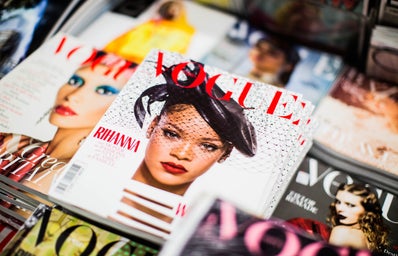For a recent school project, I needed to write an essay about significant events within fashion, so I decided to write about the fashion magazine industry’s transition from print to digital publishing. From publications like Vogue, Elle, and Harper’s Bazaar, which have countless pop-culture references, hopeful young writers worldwide dream of having their work featured within the glossy pages of these industry legacies.
I am part of the generation that still remembers the boom of tabloid magazines, where supermodels ruled the trends, and Paris Hilton, Britney Spears, and Lindsay Lohan were constantly snapped by paparazzi. Between characters like Carrie Bradshaw (Sarah Jessica Parker) from Sex and the City and Andy Sachs (Anne Hathaway) from The Devil Wears Prada, I always pictured myself living in my chic Manhattan apartment and typing on my iBook — the Macbook of 2005 — surrounded by boatloads of the free couture gifted by fabulous designers.
The glamorous Hollywood portrayals of the “Vogue girl” made me believe this was the job to have; nothing could beat it! However, the internet turned things upside down.
I can be the “Vogue girl” right now as I write this article while waiting for my 2 p.m. class to start — well, kinda. From today’s perspective on mass media, is there such a difference between being a writer for print and a digital content creator? Is working for a print publication even relevant anymore? Do I need the prestige of Anna Wintour’s approval?
With social media allowing for millions of opinions to be expressed instantaneously, the need for fashion print has been on the decline. From 2002 to 2022, the revenue for physical print publishing magazines fell by 40.5%, and 25% of that decline started in the 2010s when social media networks such as Instagram, Twitter, and Tumblr started gaining popularity.
Phenomenons like this started a conversation about who could translate fashion news. With the majority of publications making the switch from periodic print to digital content, even some popular fashion magazines, like Seventeen, altogether abandoned the print medium. Increased internet use gave rise to fashion commentary not on the basis of the fashion elite but on a generation of inclusivity with the new culture of expressing individual opinions.
While the consumer market has drastically changed over centuries, what remains consistent is the urgency to stay up to date with social masses, and fashion has been a physical representation of that concept spanned over thousands of years.
Hundreds of years before any fashion-related printings, the social elite would receive their fashion news through fashion dolls called Pandoras. Common throughout aristocratic European cities like Paris and London, private dressmakers for noble families used miniature lifelike marionettes to “model” concepts for contemporary court dress. Moschino actually made a call back to this era in their Spring 2021 runway show, “No strings attached.”
The dolls themselves were the early “it-girls” of their generation, as they started the information stream of persuasive marketing the fashion magazine would capitalize on. Similar to this concept, fashion plates (or cahiers) were also distributed throughout France. While rare, these were society’s first introductions to a fashion-oriented catalogue through a paid subscription, like a modern magazine.
It was not until the late 1700s, during the French Revolution, that manufacturing and the making of Pandora’s or fashion in general was halted. Due to political conflict within the country, once Napoleon gained power from the previous reigning King Louis XVI and Marie Antoinette, he disbanded any style culture that fulfilled the social functions of fashion, which divided classes and favoured aristocracy.
With that being said, this simultaneously encouraged the creation of one of the first documented fashion publications, Le Mercure Galant. The release of this magazine revolutionized fashion content on a fair and inclusive basis, with the majority of the gazette’s editorial approach to journalism, style, and reinvention being tailored to promoting “town-wear.” Rather than exclusively curating fashion as a commodity of the rich, Le Mercure Galant provided the styles of everyday society that were in urgent demand.
The magazine’s editor-in-chief (EIC), Jean Donneau de Vise, writes in an early entry, “I had promised you, Madame, to inform you of all the new styles.”
Donneau de Visé continues, “If this article about fashions can interest members of that fair sex whom we wish particularly to serve, we will take every possible step to please them and deserve their attention.”
After World War II, westerners experienced major class division, social conformity, and abundant expressions of wealth, all of which were social factors that were only expedited by fashion magazines. Publications like Vogue started targeting their print content towards the American public, and the newly appointed EIC, Diana Vreeland, made Vogue equivalent to the “fashion bible.”
Fashion publications had significant control over the social culture in which society was misdirected, learning how to appropriately express the desired level of status and values of metropolitan lifestyle — like Swedish fashion designer Matilda Djerf does for me now.
Niche interests and coinciding fashion movements dramatically increased the relationship between brands and consumers, and now that we have influencers, an entire atmosphere of direct opinion is at everyone’s fingertips.
However, former Glamour editor Jo Elvin tells The Guardian, “There is a certain prestige that comes from appearing in the print media that takes those people from the online world into a different sphere.”
“The fashion industry is a commercial behemoth with the remit of selling clothes — and lucrative, profit-heavy accessories, fragrance and cosmetics with the attached kudos of each coveted brand. Prior to the digital revolution, designers and fashion businesses were heavily dependent on the magazine industry to help them reach customers and endorse their collections,” The Guardian continues.
Imran Amed, founder and EIC of The Business of Fashion, said to The Guardian, “We are at a time of disruption in the wider world, and all businesses, in fashion and beyond, are testing new models to see what works and keeps them relevant to their audience.”
The truth of the matter is that brands no longer need to rely on writers from popular publications to give the public a good or bad review when Kim Kardashian can sit front row and show her followers what she likes.
Having this new power structure of what is wanted and what is shunned within the fashion world adjusted the status quo to amplify society’s opinion rather than consume information from the periodical issues of magazines. Additionally, there was a rise in online-oriented broadcasting, as we see in Refinery29, or even Her Campus, for that matter.
These publications, and publications alike, hold objectives less about creating niche subcultures surrounding brands but satisfy both the desire to have a plethora of voices amplified in universal conversations surrounding fashion and the “click and move on” mentality of this consumer generation.
“Magazines aren’t going to disappear,” said Bronwyn Cosgrave, former features editor at British Vogue. “People still like to have something tangible to browse.”
While continuing to exist within a style-hungry and craze-driven society, it remains crucial to assess the contributions of all perspectives in order to find one’s place within the zeitgeist that lives within fashion.
The impact of the digital age is, by no means, eradicating our future as writers, as we need to have translators of culture and design to continue to provoke the fluidity of new ideas of innovation, theory, and inspiration. Regardless of the fashion industry’s future path, writers everywhere will persist in the importance of diverse voices to drive society in ways of positive impact — and I hope to be a part of it!


